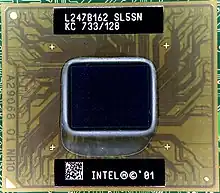Xbox technical specifications
The Xbox technical specifications describe the various components of the Xbox video game console.

The top of the Xbox, disassembled. It uses a standard DVD-ROM and Hard-disk drive via Parallel ATA.
Central processing unit

Xbox CPU
- CPU: 32-bit 733 MHz, custom Intel Pentium III Coppermine-based processor in a Micro-PGA2 package (though soldered to the mainboard using BGA). 180 nm process.[1][2][3][4]
- 133 MHz 64-bit GTL+ front-side bus (FSB) to GPU (1.06 GB/s bandwidth)[5]
- 32KB L1 cache. 128 KB on-die L2 cache
- SSE floating point SIMD. Four single-precision floating point numbers per clock cycle.
- MMX integer SIMD
Memory
- Shared graphics memory sub-system
Graphics processing unit
.png.webp)
The XGPU
- GPU and system chipset: 233 MHz "NV2A" ASIC. Co-developed by Microsoft and Nvidia and essentially a variant of Geforce 3 chips.
- Floating-point performance: 20 GFLOPS
- Geometry engine: 115 million vertices per second, 125 million particles per second (peak)
- 4 pixel pipelines with 2 texture units each
- Peak fillrate:
- Rendering fillrate: 932 megapixels per second (233 MHz × 4 pipelines)
- Texture fillrate: 1,864 megatexels per second (932 MP × 2 texture units)
- Realistic fillrate:
- Rendering fillrate: 250–700 megapixels per second, with Z-buffering, fogging, alpha blending and texture mapping[6]
- Texture fillrate: 500–1400 megatexels per second (250-700 MP × 2 texture units)
- Peak triangle performance: 29,125,000 32-pixel triangles per second, raw or with 2 textures and lighting (32-pixel divided from peak fillrate)
- 485,416 triangles per frame at 60 frames per second
- 970,833 triangles per frame at 30 frames per second
- Realistic triangle performance: 7,812,500–21,875,000 32-pixel triangles per second, with 2 textures, lighting, Z-buffering, fogging and alpha blending (32-pixel divided from realistic fillrate)
- 130,208–364,583 triangles per frame at 60 frames per second
- 260,416–729,166 triangles per frame at 30 frames per second
- 4 textures per pass, texture compression, full scene anti-aliasing (NV Quincunx, supersampling, multisampling)
- Bilinear, trilinear, and anisotropic texture filtering
- Performance lies between a Geforce 3 Series GPU and a Geforce 4 Series GPU. This is due to the added vertex shader present on the ASIC, thus doubling the vertex output compared to Geforce 3 ASICs. Clock speed is the same as the original Geforce 3 series GPU (233MHz) thus slower than Geforce 4 series starting at 250MHz.[7]
Storage
_HDD_(40932184041).jpg.webp)
An original Xbox hard disk drive.
Audio

The Xbox motherboard.
- Audio processor: NVIDIA "MCPX" (a.k.a. SoundStorm "NVAPU")
- Wolfson Microelectronics XWM9709 AC97 Revision 2.1 Audio Codec
- Integrated Parthus DSP for realtime Dolby Digital encoding
- 64 3D sound channels (up to 256 stereo voices)
- HRTF Sensaura 3D enhancement
- MIDI DLS2 Support
- Monaural, Stereo, Dolby Surround, Dolby Digital Live 5.1, and DTS Surround (DVD movies only) audio output options
Connectivity

The Xbox has a standard AC in, A/V connector and Ethernet port.
left "High Definition AV Pack", right HDMI
- Controller ports: 4 proprietary USB 1.1 ports
- A/V outputs: composite video, S-Video, component video, HDMI (via 3rd party), SCART, Digital Optical TOSLINK, and stereo RCA analog audio
- S-Video requires "Advanced AV Pack", component video requires "High Definition AV Pack", TOSLINK requires either of the two
- Resolutions: 480i, 480p, 576i, 576p, 720p, 1080i
- Integrated 10/100BASE-TX wired Ethernet with ICS ICS1893AF Physical Layer Transceiver
- DVD movie playback (add-on required)
Physical specifications
See also
References
- "Microsoft announces X-BOX". 2000-04-07. Archived from the original on 2000-04-07. Retrieved 2020-08-14.
- "xbox.com || hardware || consoles || xbox video game system". 2001-10-06. Archived from the original on 2001-10-06. Retrieved 2020-08-14.
- XBox Specs - IGN, 2001-10-02, retrieved 2020-08-14
- "CES 2001: Microsoft Unveils the Xbox Console". GameSpot. 2001-01-06. Retrieved 2020-08-14.
- "Hardware Behind the Consoles: Microsoft's Xbox". Anandtech. 2001-11-21. Archived from the original on 2016-06-27. Retrieved 2017-05-20.
- Graphics Processor Specifications, IGN, 2001
- "Hardware Behind the Consoles - Part I: Microsoft's Xbox - The X-IGP". Anandtech.com. 2001-11-21. Retrieved 2010-11-11.
- Original Xbox Technical Specifications Archived October 10, 2010, at the Wayback Machine
This article is issued from Wikipedia. The text is licensed under Creative Commons - Attribution - Sharealike. Additional terms may apply for the media files.

